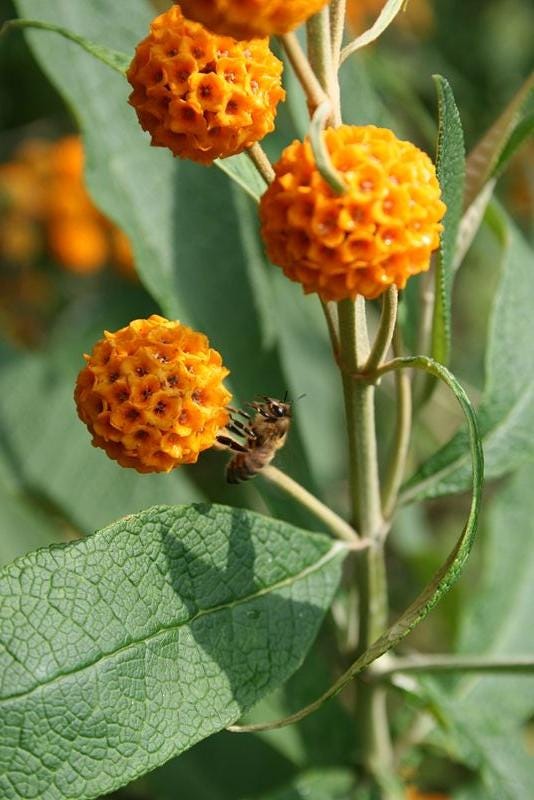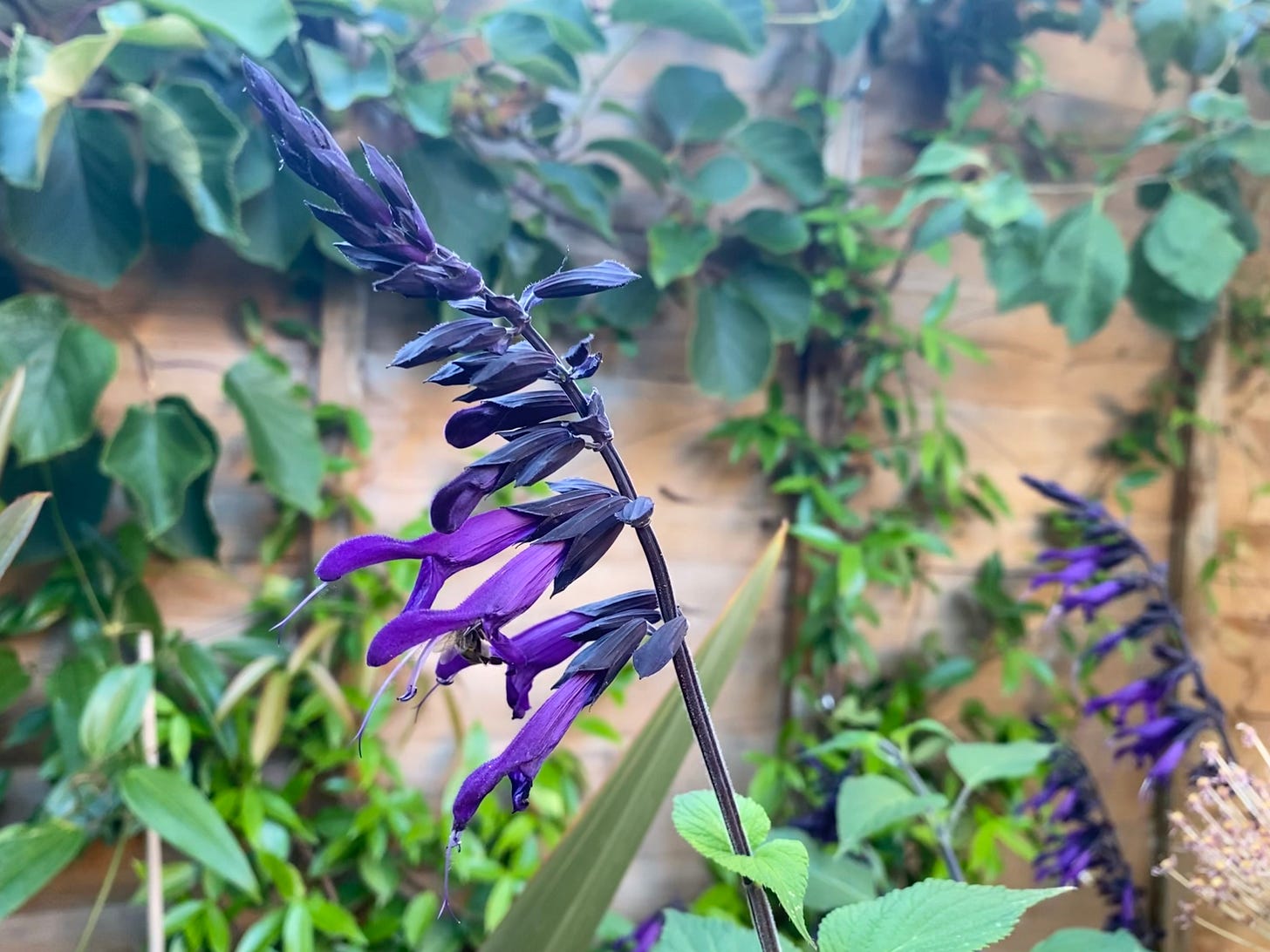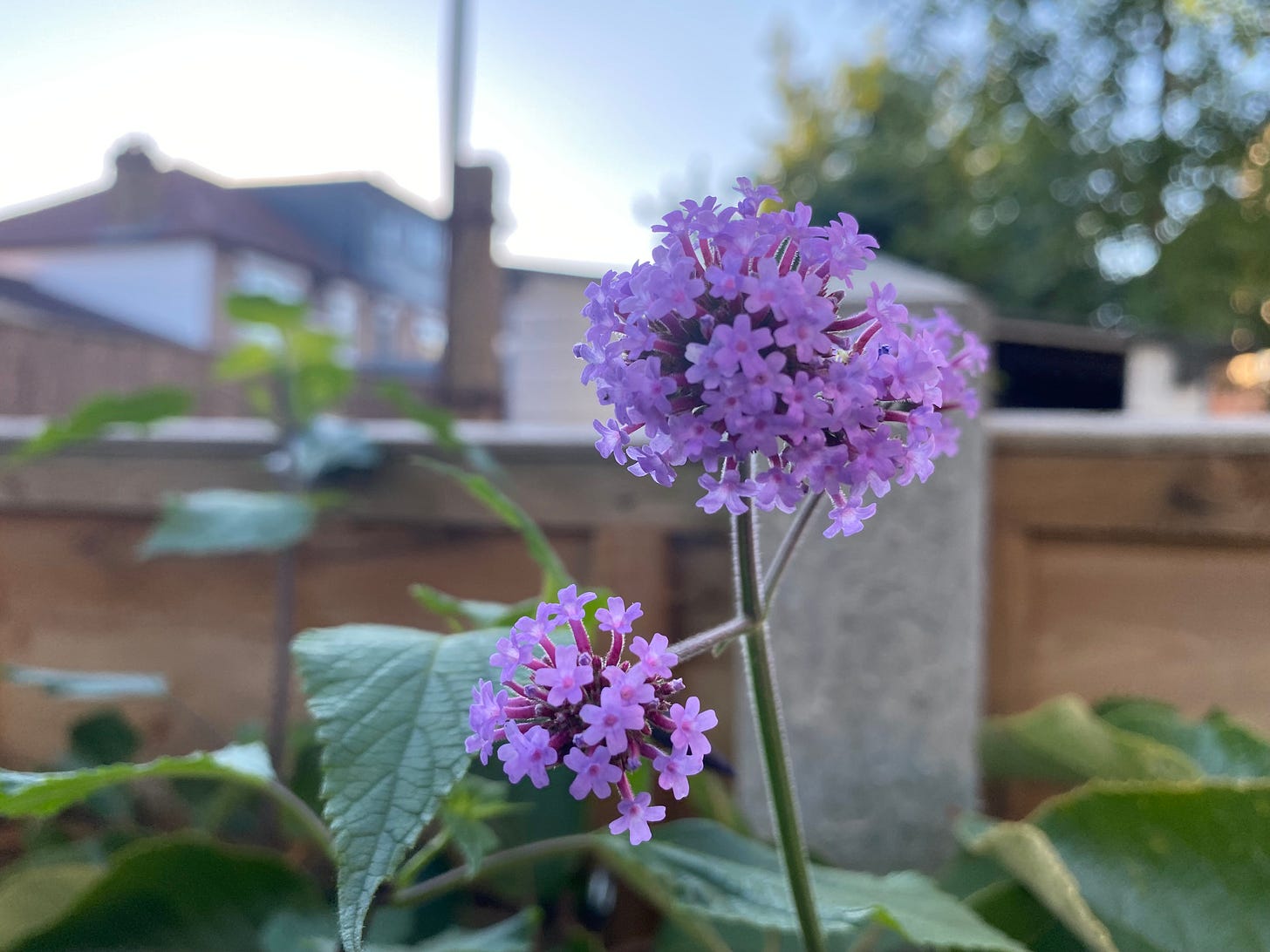The colour purple, lots of lovely links, and one big thank you
Back on home soil, and sharing a whole load of recommendations
Welcome to The Earthworm, an alternative gardening newsletter. The Earthworm is a reader-supported publication, which means it only exists thanks to the generous support of lovely people just like you. The two best ways you can support my work are to share this newsletter with a friend, and to consider upgrading to a paid subscription. Whether you’re a first-time reader or a long-time subscriber, thanks for being here. I hope you enjoy today’s post.
A week is a long time in the garden. This is particularly true if you have an abundance of pots and planters, as I do.
During a hot spell, such as the one we’ve had (and are still in the midst of) here in the UK, any moisture in containerised soil is quickly either slurped up by thirsty plants, or simply evaporates away. Leave pots unattended in these conditions for even a couple of days, and you can kiss goodbye to your dreams of sinking your teeth into a plump homegrown tomato later in the summer.
So thank goodness for good neighbours. Emily, who lives four doors down, kindly and dutifully and diligently took on irrigation duties while we were stateside. No small ask, given the number of little pots, big pots, hanging baskets, upright planters, and delicate seedlings clogging up our back garden. It is a joy and a relief to return from holiday and be met not with wilt and decay, but new flowers, fruit and vigorous growth.
My advice to you, reader, no matter how large or small your outdoor space: find yourself an Emily, and keep her well-provisioned with snacks.
Meanwhile, the garden has entered a real purple patch. Literally, that is: everywhere I look, I see purple. In the sunny border, in the short (in human terms) week that we were away, the first bright landing pads have appeared on the Verbena bonariensis; silver sprigs of lavender are now topped with little lilac lanterns; and spikes of deep purple Salvia ‘Amistad’ blooms have staked their territory – they’ll flower away now until they get cut down, either by frost or, if we get another mild winter, by me in spring 2023.
On the shady border, meanwhile, purple-black foliage dominates, thanks to the ‘Black Lace’ elder and the Angelica sylvestris ‘Ebony’ – both of which are must-haves in the Goth Garden I pray someone will ask me to design for them one day.
And alongside these, the hydrangea is cheerily waving its purple pom-poms. In previous years, I’ve battled the flowers’ natural tendency towards pink (we have a pH neutral-ish clay soil) by mulching generously with ericaceous (ie, acidic) compost, which turns the blooms blue. This year, I didn’t bother, and am enjoying the purple-ish, pink-ish display.
Spring, especially in wild or public spaces, is characterised by yellow. Daffodils, dandelions, buttercups, gorse, cowslip, and more announce the new season with a succession of sunny blooms. But in my garden I know it is well and truly summer when I see purple.
And now, some links. It occurs to me that, from time to time, you might be interested to read or hear about some of the things that have caught my eye/ear. What follows is a list of genuine recommendations. No money has changed hands, no favours have been called in – if it’s here, it’s because I’ve enjoyed it, and thought you might too.
Butterfly buddy
Speaking of purple, one of the first things I noticed on our journey home from Heathrow was the arrival of the buddleja. A lot of people have a snobbish dislike for buddleja, no doubt owing to their ubiquity on roadsides, urban wastelands and even the cracks in the brickwork of railway bridges. But I love a buddleja.
They don’t call it the butterfly bush for nothing, you know. I once saw one in a pub beer garden in Suffolk, and it was absolutely covered – no, buried – in butterflies. Positively teeming with the things. If you want the bees and the butterflies, and the glorious scent, but don’t like purple, or don’t fancy growing a “weed” in your garden, then maybe you’d consider a Buddleja globosa, with its little spheres of sunshine-yellow flowers. It’s right at the top of my shopping list – I just need to find the space for it first…

Organic matters
Jan Johnsen is an American landscape designer and author. If you don’t already subscribe to her Substack, Gardentopia, you should! But first, read this post: ‘My tale about the Rise of Organic Farming’. I found it fascinating to hear about the early days of the organics movement, if a little disheartening to think that it is still being met with the same resistance from the agricultural establishment now as it was back then.
Hawk eyes
Northport, the nearest town to where we were staying on our Long Island holiday, is currently being besieged by a hawk. The bird – which I got a glimpse of myself, twice – has developed a habit of swooping down from on high and clawing the backs of people’s heads. Parents are afraid to take their children to the playground. Pedestrians warily eye the sky as they go about their errands. It’s sort of funny, sort of terrifying, that an entire town can be in the thrall of a small bird.
Closer to home, meanwhile, this charming story in the Guardian illustrates how hawks and other birds of prey are an unrivalled ‘environmental control’ when it comes to deterring airborne pests, especially at airports and major sports events, such as Wimbledon.
The piano king
Earlier this week, bleary-eyed and jet-lagged, I spoke with legendary food writer, grower and cook Mark Diacono. Look out for that interview here on The Earthworm in the very near future. In the meantime, you might be interested to take a look at Mark’s own recently launched Substack, The Imperfect Umbrella. I loved this post, which has nothing to do with gardens and growing, but instead tells the story of arguably the most important piano in pop/rock history, as heard on iconic tracks by The Beatles, David Bowie, Lou Reed, Elton John, The Rolling Stones, and more.
And a word of advice for audiophiles
I don’t listen to music when I’m writing. Can’t do it. I never mastered passive listening, letting sound wash over me – if there is a noise to be heard, radio, podcast or song, my ears will tune in to it. My eyes glaze over, and the only words I can form in my brain are the ones I’m hearing. Gardening, however, offers a perfect opportunity for active listening. The nursery run is where I listen to podcasts; in the garden, it is music.
The problem I’ve had in the past, however, is how to listen. My preferred over-ear headphones are too bulky, and have a tendency to slide off my head when I lean over. I could turn the volume up on our kitchen radio, but that’s a little antisocial. The solution, it turned out, had been sitting in my wife’s handbag all along. Her ‘Jlab Audio Epic Air Sport’ headphones are sweat-resistant (they’re designed for runners) and clip around the ear, to hold them in place. So I can now enjoy listening to the latest single from Phoenix whilst neck-deep inside a shrub. Everyone’s a winner! (Except my wife, who can never find her headphones.)
Do you have any recommendations for me, or the wider Earthworm community? I’m all ears! As per usual, you can either leave a comment below or, if you’re feeling shy, hit reply (if you’re reading the email edition of this post) and drop me a direct note. I read and reply to all reader correspondence.






I’d like to read more about those plans for your Goth Garden! Maybe they’ll let you build it at the next Gardeners’ World Live?
I'm glad you had an Emily to take care of your garden while you were away. We went on holiday recently and were fortunate to have pet sitters who were willing to add a bit of plant care to their daily rota.
And congratulations on being featured in Substack's "What to Read" feature!